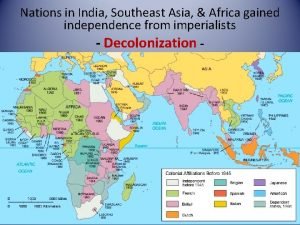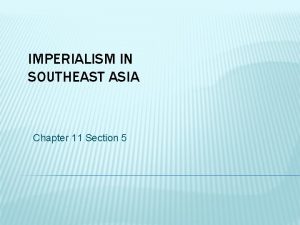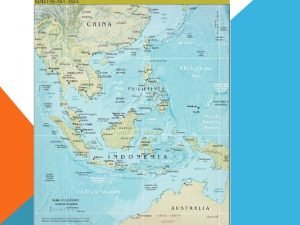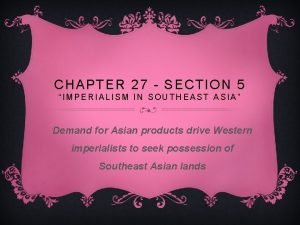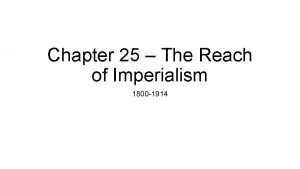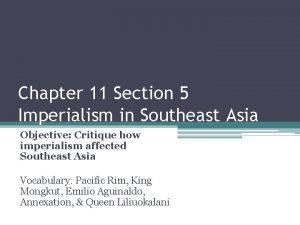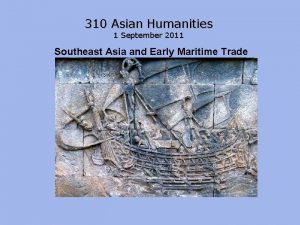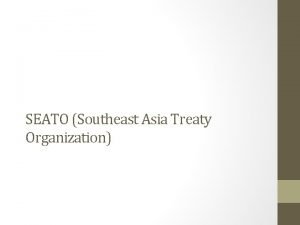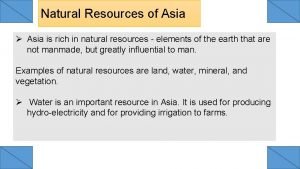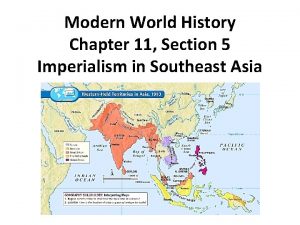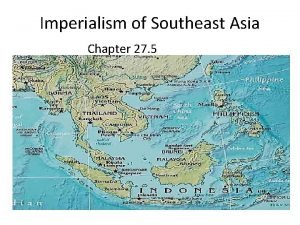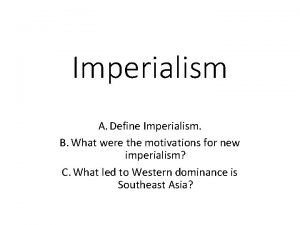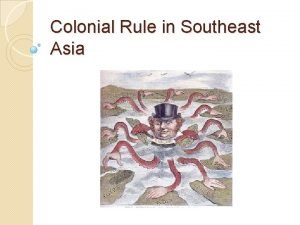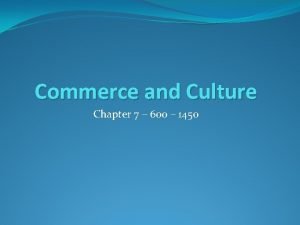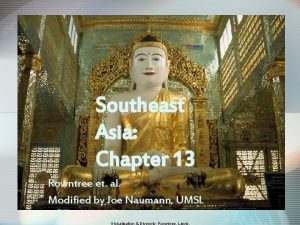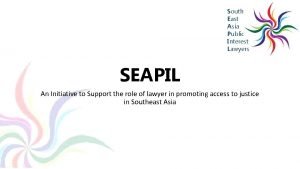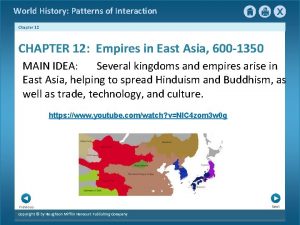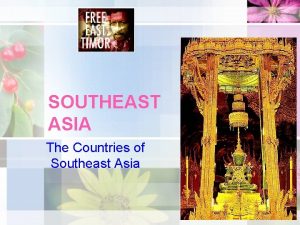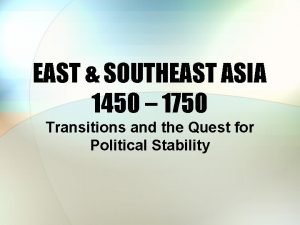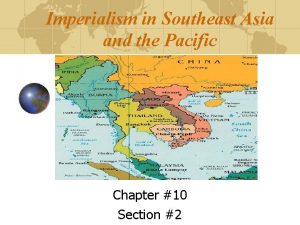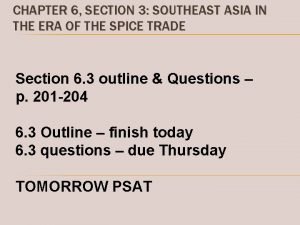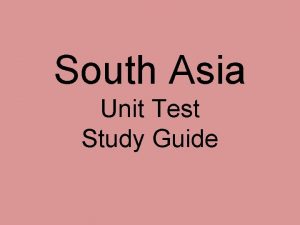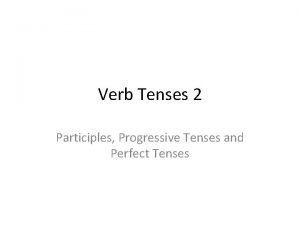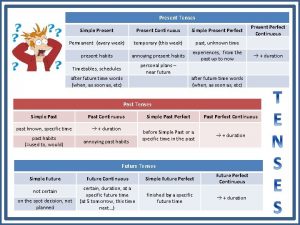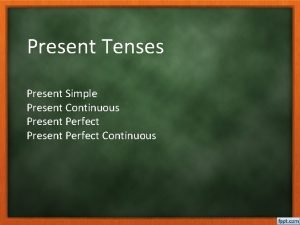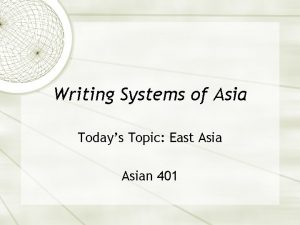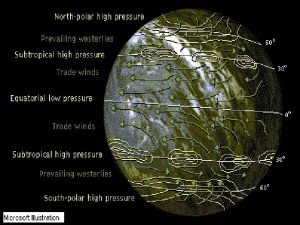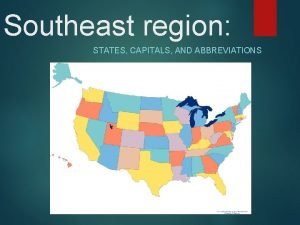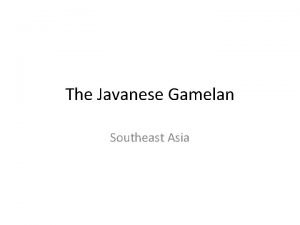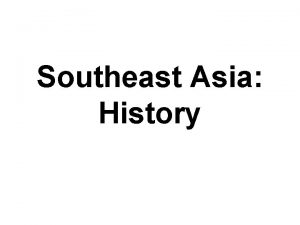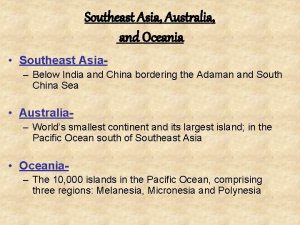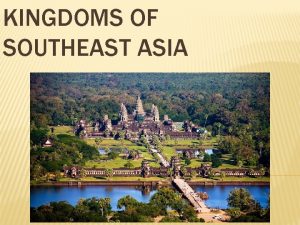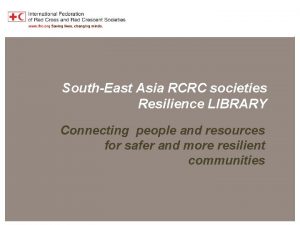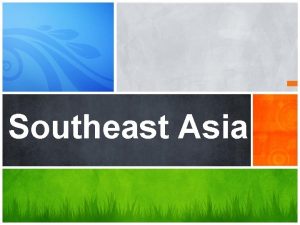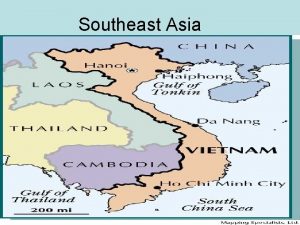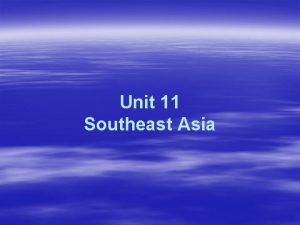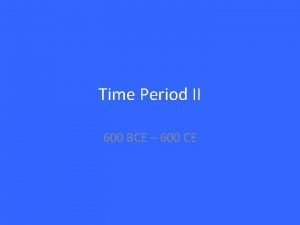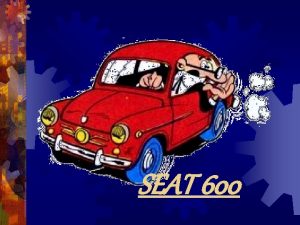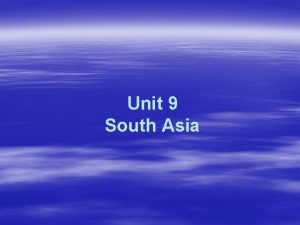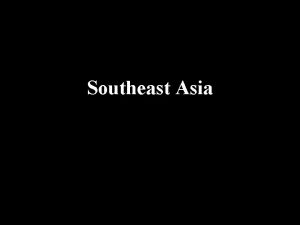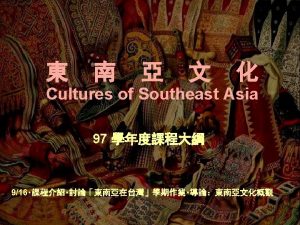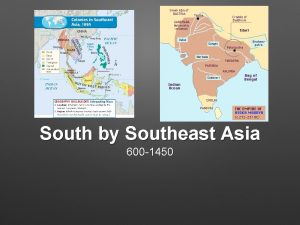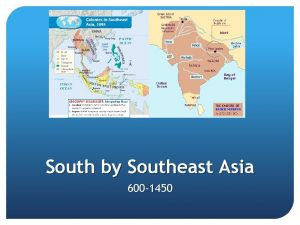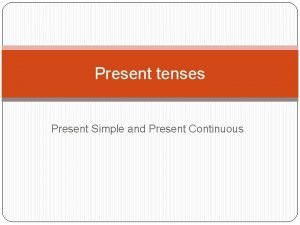Southeast Asia 600 AD to Present Unit 3











































- Slides: 43

Southeast Asia (600 AD to Present) Unit 3

Feudal Powers in Japan Chapter 12, Section 4

Shinto • Meaning: way of the gods • Different clans in Japan worshipped different gods; altogether thousands of nature gods/goddesses. • Varied customs and beliefs combined into one religion – Shinto

Samurai • Meaning: one who serves • Rival landlords surrounded themselves with loyal bodyguards or warriors called Samurai. • Late 1100 s to 1868 warrior class secured national power and dominated Japanese government. • Females could also be samurai.

Bushido • Meaning: the way of the warrior • Unwritten code followed by Samurai warriors. • A samurai was expected to show o Reckless courage o Reverence for gods o Generosity and benevolence to those weaker than himself • Dying an honorable death was more important than a long life.

Shogun • Meaning: supreme general to emperor’s army • Title given to military leader in 1192 after the Minamota family won clan war. • Shoguns had power of military dictator. • Ruled Japan from 1200 s through puppet emperors.

Kingdoms of SE Asia and Korea Chapter 12, Section 5

Khmer Empire • Today known as Cambodia • From 800 s to 1200 s they were main power on Southeast Asian mainland. • Conquered neighboring kingdoms and became empire. • Build waterways and irrigation systems; improved rice cultivation to 3 or 4 crops/year.

Angkor Wat • One of greatest architectural feats in the world covering nearly a square mile; largest religious construction in world. • Built in sandstone as symbolic mountain dedicated to Hindu god Vishnu. • Style shows Indian influence. • Carvings done directly on stone; covered in gold.

Sailendra Dynasty • Includes Southeast Asian Islands – Sumatra, Burma, Java. • Great agricultural expertise. • Built Buddhist temple at Borobudur; strong Indian influence. • Has nine terraced levels like stepped pyramid. • Ninety-two Dhyani Buddha statues.

Srivijaya Dynasty • Overpowered Sailendra Dynasty; ruled 7 th – 13 th Century. • Controlled Strait of Malaca and other waters around islands. • Became wealthy by taxing trade passing through waters. • The capital, Palenbang, became great center of Buddhist learning. Monks from China, India, and Java used to congregate here to learn and teach the lessons of Buddha.

Ly Dynasty • Located in area today known as Vietnam. • Ruled by China during Han dynasty; became independent around 900 A. D. – known as Dai Viet. • Affected by Chinese cultural influences, but preserved independent culture and way of life. • Encourage agriculture and trade; improved road and water transportation.

Korea (Modern) • Two sides to Korean culture: o Distinct people with own native traditions o Culture was shaped by Chinese influences and adapted to suit own needs • Today arbitrarily divided into two countries: o North Korea o South Korea.

Koryu Dynasty • Lasted about 4 centuries 935 -1392. • Government and civil service system modeled on Chinese model. • Despite examination system sons of aristocracy still received best positions which became hereditary. • Period marked by cultural achievements, e. g. light green celadon pottery.

Japan Returns to Isolation Chapter 19, Section 3

Warring States Period • 1467 -1568 • Powerful shoguns in north and south fought one another for power. • Japanese feudal system collapsed; centralized rule ended. • Powerful samurai seized control of the country.

Daimyo • Powerful warrior chieftain seized control of states. • Offered protection to peasants in return for loyalty; known as Daimyo, meaning great name. • Security came from powerful warlords; emperor became mere figurehead.

Oda Nobunaga • Vicious and brutal daimyo who defeated his enemies and took control of Kyoto in 1568. • Wanted to eliminate all enemies; killed rivals and attacked monasteries associated with opposition. • Unable to unify country; committed ritual suicide of samurai (“seppuku”) when general turned on him.

Toyotomi Hideyoshi • Nobunga’s best general; continued mission to destroy enemy. • Controlled most of country by 1592. • Wanted to conquer China; invaded Korea in 1592. • When he died six years later his troops withdrew.

Tokugawa Ieyasa • Completed unification of Japan in 1600. • Defeated enemies in Battle of Sekigara; earned loyalty of other daimyo across country. • Three years later became sole ruler (shogun); moved capital to Edo (later Tokyo).

Tokugawa Shogunate • Ieyasu restored centralized government by requiring local daimyo to stay in capital every other year. • Founded Tokugawe Shogunate which held power until 1867. • Later rulers followed advice to be virtuous, and not to neglect, but protect country; allowed for order in Japan. • Period of cultural growth followed.

Haiku • Haiku is a very short form of Japanese poetry. • Consists of 17 syllables in three lines of 5, 7 and 5 syllables respectively. • Juxtaposition of two images or ideas and a "cutting word" between them which signals the moment of separation.

Kabuki • Form of Japanese theater. • Actors o are in elaborate costumes, o use music, dance and mime o perform skits of everyday life

Imperialism in SE Asia Chapter 27, Section 5

Pacific Rim • As they did in Africa, European powers wanted to carve up countries in SE Asia. • Made highly desirable by strategic location on route to China. • Colonies provided: o tropical agriculture (included sugar cane, coffee, cocoa, rubber, coconuts, bananas, pineapples) o minerals o oil

European Expansion • Dutch East India Company controlled Malacca, Java, Sumatra, parts of Borneo, Celebes, the Moluccas and Bali. • Britain confiscated Singapore – an island just off Malay Peninsula. • France controlled Indochina; later Laos, Cambodia and North Vietnam.

King Mongkut • Siam (today Thailand) lay between Burma (British controlled) and French Indochina. • Remained free from European control. • Kings promoted Siam as a neutral zone. • King Mongut and his son modernized country by promoting education reforming legal system reorganizing government building railroads and telegraph systems o ending slavery o o

Emilio Aguinaldo • USA acquired the Philippine Islands, Puerto Rico and Guam in 1808 after Spanish-American War. • Filipino nationalists under Emilio Aguinaldo declared independence and established Philippine Republic. • Struggle between USA and Philippines – USA won.

Annexation of Hawaii • Many Americans established sugar plantations on Hawaii; brought wealth to Hawaii. • Mc. Kinley Tariff Act in 1890 caused sugar from Hawaii to cost same as sugar from elsewhere; producers lost money. • Pushed for annexation so Hawaii could be part of USA; would bring bigger profits to producers of sugar.

Queen Liliuokalani • Took to throne in 1893; new constitution to increase her power. • Would also restore power of Hawaiians at expense of plantation owners. • American business men hatched plot to overthrow monarchy; new president asked USA to annex Hawaii. • Hawaii became part of USA in 1898.

Modernization in Japan Chapter 28, Section 2

Treaty of Kanagawa • U. S. Commodore Matthew Perry took four steam ships into Tokyo harbor in 1853; steamships and cannons astounded Japanese. • Letter from Pres. Millard Fillmore requested shogun to allow free trade between Japan and U. S. • Perry promised to be back year later with bigger fleet; Japan thus forced to agree to Treaty of Kanagawa in 1853. • Forced Japan to open doors to U. S. ; soon followed by other countries.

Meiji Era • Japanese angry at ruling shogun for opening Japan to foreigners; turned to young emperor – Mutsuhito. • Shogun stepped down; Mutsuhito, who represented Japanese pride and nationalism, took control of government. • Reign lasted 45 years; known as Meiji Era – meaning “enlightened rule”.

Imperial Japan • By 1890 Japan had become strongest military power in Asia: o several dozen warships o 500, 00 well-trained soldiers • Gained military, political and economic strength; abolished extraterritorial rights of foreigners.

Japan and China • Japan signed agreement with China not to invade Korea; China broke it and Japan protested by sending troops to fight Chinese in Korea. • Treaty with China led to Japan now owning colonies – Taiwan and Pescadores Islands. • Balance of power changed – Russia and Japan major powers in Asia.

Russo-Japanese War • Russia and Japan at war over Manchuria; 1903 Japan offered to withdraw if Russia agreed to stay out of Korea; Russia refused. • February 1904 Japan launched surprise attack on Russian ships off coat of Manchuria, resulting in war. • Japan drove Russia out of Korea and destroyed Baltic fleet. • Treaty of Portsmouth gave captured areas to Japan; Russia forced to withdraw.

Annexation • After defeating Russia, Japan made Korea a protectorate; sent in advisors who grabbed power from Korean leaders. Korean king forced to give up power • 1910 Korea was officially annexed by Japan; harsh and oppressive rule followed that was ignored by rest of the world.

SE Asian Nations Gain Independence Chapter 34, Section 2

Ferdinand Marcos • Elected president of Philippines 1965. • Imposed authoritarian rule over subjects; stole money from public treasury. • Constitution allowed only eight years of rule, but got around that by imposing martial law 1972 -1981. • Chief opponent, Benigno Aquino, was assassinated.

Corazon Aquino • Widow of Benigno Aquino challenged Marcos; won, but Marcos refused to acknowledge her victory. • Public outcry forced him into exile. • $475 million recovered that Marcos had stolen. • Promised more open and democratic government.

Aung San Suu Kyi • Burma (Myanmar) suffered much political turmoil after independence; conflict between repressive military forces and pro-democratic forces. • Aung San Suu Kyi won Nobel Peace Prize for efforts to establish democracy in Myanmar; unable to accept in person as under house arrest.

Sukarno • Led effort to establish independent Indonesia; claimed independence two days after Japan surrendered in 1945. • Independence granted by Dutch four years later. • Diverse and populous nation; unsuccessful in stabilizing economy – inflation rose to 1, 000%!

Suharto • Attempted coup in 1965; suppressed by general Suharto. • Seized power for himself; nearly 1 million Indonesians killed. • Indonesia became police state; bribery and corruption commonplace. • Sukarno’s daughter (Megawati Sukarnoputri) now president; moving towards democracy.
 Southeast asia model
Southeast asia model Landforms of southeast asia
Landforms of southeast asia Mainland of southeast asia
Mainland of southeast asia Is india southeast asia
Is india southeast asia Chapter 27 section 5 imperialism in southeast asia
Chapter 27 section 5 imperialism in southeast asia Mon khmer
Mon khmer Chapter 11 section 5 imperialism in southeast asia
Chapter 11 section 5 imperialism in southeast asia Chapter 25 lesson 2 empire building in africa
Chapter 25 lesson 2 empire building in africa Lesson 1 physical geography of southeast asia
Lesson 1 physical geography of southeast asia Imperialism in southeast asia chapter 11 section 5
Imperialism in southeast asia chapter 11 section 5 Southeast asian alphabets
Southeast asian alphabets Countries in southeast asia
Countries in southeast asia Natural resources in southeast asia
Natural resources in southeast asia Chapter 11 section 5 imperialism in southeast asia
Chapter 11 section 5 imperialism in southeast asia Chapter 27 section 5 imperialism in southeast asia
Chapter 27 section 5 imperialism in southeast asia Define imperialize
Define imperialize Colonial rule in southeast asia
Colonial rule in southeast asia Spice chart
Spice chart Sea roads as a catalyst for change southeast asia
Sea roads as a catalyst for change southeast asia Countries in southeast asia
Countries in southeast asia Countries in southeast asia
Countries in southeast asia Seapil
Seapil Chapter 12 section 5 kingdoms of southeast asia and korea
Chapter 12 section 5 kingdoms of southeast asia and korea Insular southeast asia
Insular southeast asia Southeast asia 1450 to 1750
Southeast asia 1450 to 1750 Imperialism in southeast asia and the pacific
Imperialism in southeast asia and the pacific In 1500 mainland southeast asia was a relatively
In 1500 mainland southeast asia was a relatively Nilai dari sin 600 + tg 600 adalah
Nilai dari sin 600 + tg 600 adalah Perpetuity formula
Perpetuity formula Unit 10, unit 10 review tests, unit 10 general test
Unit 10, unit 10 review tests, unit 10 general test Unit 1 present simple and present continuous
Unit 1 present simple and present continuous South asia unit test
South asia unit test Present perfect present simple present continuous
Present perfect present simple present continuous Difference between present perfect simple and continuous
Difference between present perfect simple and continuous Present continuous schema
Present continuous schema Relative clause noredink
Relative clause noredink Run present perfect
Run present perfect Present simple present continuous present perfect
Present simple present continuous present perfect Present simple present continuous and present perfect
Present simple present continuous and present perfect Southeast asian writing systems
Southeast asian writing systems Southeast trade winds
Southeast trade winds Physical features of the southeast region
Physical features of the southeast region Southeast region agriculture
Southeast region agriculture Us state capitals southeast region
Us state capitals southeast region



